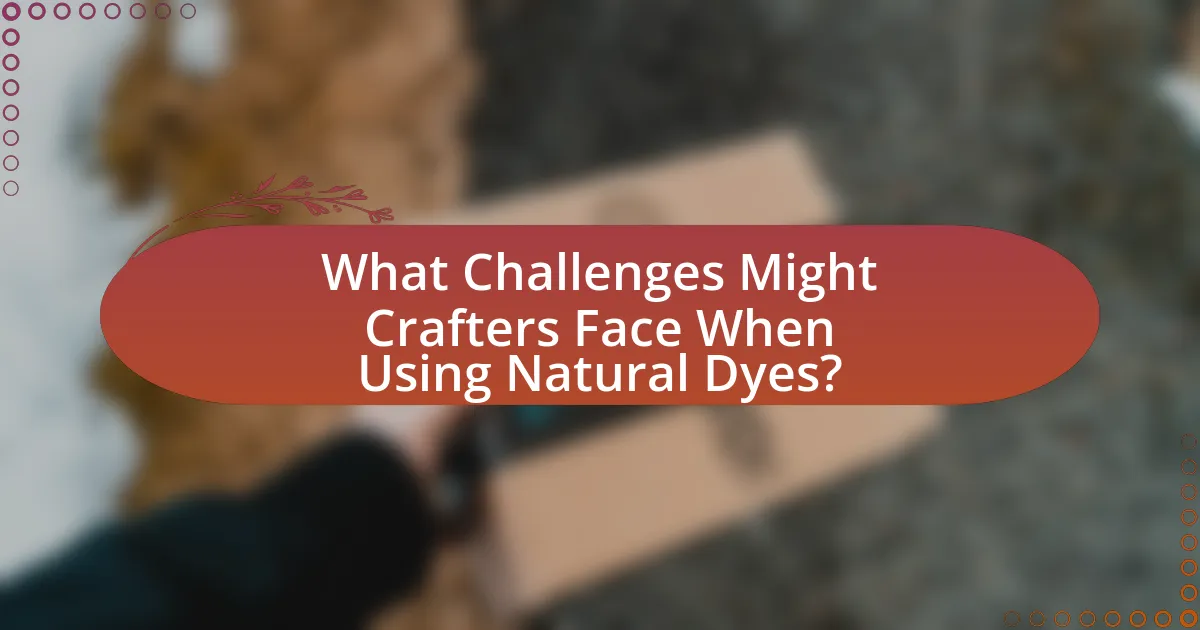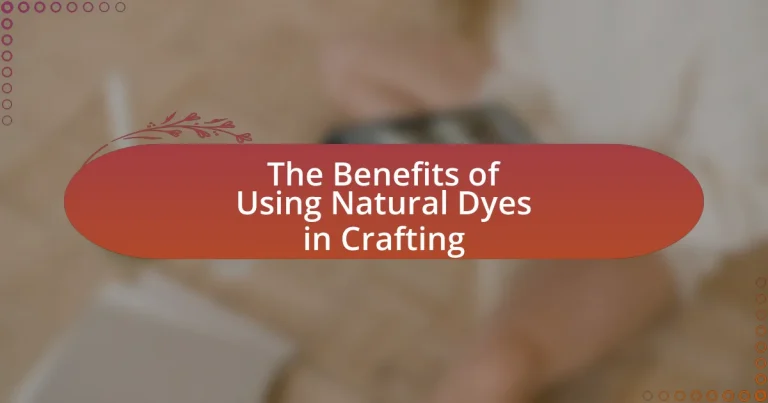Natural dyes are colorants sourced from plants, minerals, and insects, used in crafting to color textiles, paper, and other materials. This article explores the benefits of natural dyes, highlighting their eco-friendliness, health advantages, and unique aesthetic qualities compared to synthetic dyes. It discusses the dyeing process, sources of natural dyes, and the environmental benefits they provide, such as reducing pollution and promoting biodiversity. Additionally, the article addresses challenges crafters may face, including color consistency and fading, while offering practical tips for beginners interested in experimenting with natural dyeing techniques.

What are Natural Dyes and How are They Used in Crafting?
Natural dyes are colorants derived from natural sources such as plants, minerals, and insects, used in crafting to impart color to textiles, paper, and other materials. These dyes are utilized in various crafting techniques, including fabric dyeing, painting, and printing, allowing artisans to create vibrant, eco-friendly products. Historical evidence shows that natural dyes have been employed for thousands of years, with examples like indigo from the indigo plant and cochineal from insects being prominent in traditional dyeing practices. The use of natural dyes not only enhances the aesthetic appeal of crafted items but also promotes sustainability by reducing reliance on synthetic chemicals.
How do natural dyes differ from synthetic dyes?
Natural dyes are derived from natural sources such as plants, minerals, and insects, while synthetic dyes are chemically manufactured. The primary difference lies in their origin; natural dyes are biodegradable and often less harmful to the environment, whereas synthetic dyes can contain toxic chemicals and may contribute to pollution. For example, natural indigo is sourced from the indigo plant, while synthetic indigo is produced through chemical processes. Additionally, natural dyes often produce softer, more muted colors, while synthetic dyes can achieve brighter and more vibrant hues. This distinction highlights the environmental and aesthetic implications of choosing between natural and synthetic dyes in crafting.
What sources are used to create natural dyes?
Natural dyes are created from various organic sources, including plants, insects, and minerals. Plant sources include roots, leaves, flowers, and fruits, such as indigo from the indigo plant, madder root for red hues, and turmeric for yellow. Insects, like cochineal, provide vibrant reds, while minerals can yield colors like ochre and umber. Historical evidence shows that civilizations have utilized these sources for thousands of years, demonstrating their effectiveness and sustainability in dyeing processes.
How is the dyeing process conducted with natural dyes?
The dyeing process with natural dyes is conducted by extracting color from plant materials, minerals, or insects and applying it to textiles. Initially, the raw materials, such as leaves, roots, or flowers, are boiled in water to release their pigments. This extraction process can take several hours, depending on the material used. After extraction, the fabric is prepared, often through a mordanting process, which involves treating the fabric with substances like alum or tannin to enhance dye adherence. Once the fabric is mordanted, it is submerged in the dye bath, allowing the natural pigments to bond with the fibers. The duration of this immersion can vary, typically ranging from 30 minutes to several hours, depending on the desired color intensity. Finally, the dyed fabric is rinsed and dried, completing the process. Historical evidence shows that civilizations have utilized natural dyes for thousands of years, with documented practices in ancient Egypt and India, confirming the effectiveness and longevity of this dyeing method.
Why is the use of natural dyes gaining popularity in crafting?
The use of natural dyes is gaining popularity in crafting due to their eco-friendliness and health benefits. As consumers become more environmentally conscious, they prefer sustainable materials that minimize harm to the planet. Natural dyes, derived from plants, minerals, and insects, offer a biodegradable alternative to synthetic dyes, which often contain harmful chemicals. Additionally, natural dyes are less likely to cause allergic reactions, making them safer for artisans and consumers alike. The rise in demand for organic and sustainable products has led to a resurgence in traditional dyeing techniques, further driving interest in natural dyes within the crafting community.
What environmental benefits do natural dyes provide?
Natural dyes provide significant environmental benefits by reducing pollution and promoting biodiversity. Unlike synthetic dyes, which often contain harmful chemicals that can contaminate water sources, natural dyes are derived from plants, minerals, and insects, resulting in less toxic waste. For instance, a study published in the Journal of Cleaner Production found that natural dye processes can reduce water pollution by up to 50% compared to synthetic alternatives. Additionally, the cultivation of dye plants can enhance soil health and support local ecosystems, as these plants often require less water and fewer pesticides. This sustainable approach not only minimizes environmental impact but also encourages the preservation of traditional agricultural practices.
How do natural dyes contribute to sustainable crafting practices?
Natural dyes contribute to sustainable crafting practices by providing eco-friendly alternatives to synthetic dyes, which often contain harmful chemicals. These natural dyes are derived from renewable resources such as plants, minerals, and insects, reducing environmental impact and promoting biodiversity. For instance, using indigo from the indigo plant or cochineal from insects minimizes pollution and waste associated with synthetic dye production. Additionally, natural dyes often have a lower carbon footprint, as they can be sourced locally and require less energy-intensive processes. This shift towards natural dyes supports sustainable agriculture and encourages the use of organic materials, further enhancing the sustainability of crafting practices.

What are the Specific Benefits of Using Natural Dyes in Crafting?
Using natural dyes in crafting offers several specific benefits, including environmental sustainability, safety for health, and unique aesthetic qualities. Natural dyes are derived from plants, minerals, and insects, making them biodegradable and less harmful to the environment compared to synthetic dyes, which often contain toxic chemicals. Additionally, natural dyes are generally safer for human health, reducing the risk of skin irritation and allergic reactions that can occur with synthetic alternatives. Furthermore, the color palette produced by natural dyes is often richer and more varied, as the hues can change based on factors like the dyeing process and the materials used, resulting in unique and one-of-a-kind finished products.
How do natural dyes enhance the aesthetic quality of crafted items?
Natural dyes enhance the aesthetic quality of crafted items by providing rich, vibrant colors that are often more complex and varied than synthetic alternatives. These dyes, derived from plants, minerals, and insects, create unique hues that can evoke a sense of nature and authenticity in the finished product. For example, indigo produces deep blues, while madder root yields a range of reds, allowing artisans to achieve a spectrum of shades that reflect the natural world. Additionally, the use of natural dyes often results in softer, more muted tones that can complement the textures and materials of crafted items, enhancing their visual appeal. Studies have shown that items dyed with natural substances tend to have a more organic look, which can increase their desirability and perceived value among consumers.
What unique color palettes can be achieved with natural dyes?
Unique color palettes achieved with natural dyes include a wide range of hues derived from plants, minerals, and insects. For example, indigo produces deep blues, while madder root yields vibrant reds and pinks. Yellow can be obtained from turmeric or weld, and green shades can be created by combining yellow and blue dyes. Additionally, natural dyes can produce subtle variations in color through different mordants, such as alum or iron, which can shift the palette to warmer or cooler tones. Historical practices show that cultures worldwide have utilized these natural sources, resulting in distinct color palettes that reflect their environment and resources.
How do natural dyes affect the texture and feel of materials?
Natural dyes can enhance the texture and feel of materials by interacting with the fibers during the dyeing process. This interaction often results in a softer hand feel and improved drape, as natural dyes can penetrate the fibers more deeply than synthetic dyes. For example, studies have shown that fabrics dyed with natural substances like indigo or madder root exhibit increased softness and a more pleasant tactile experience compared to their synthetic counterparts. Additionally, the use of mordants in natural dyeing can further modify the texture, making the material feel more luxurious and enhancing its overall quality.
What health benefits are associated with using natural dyes?
Natural dyes offer several health benefits, primarily due to their non-toxic and biodegradable nature. Unlike synthetic dyes, which can contain harmful chemicals and allergens, natural dyes are derived from plants, minerals, and insects, reducing the risk of skin irritation and allergic reactions. For instance, turmeric, a common natural dye, has anti-inflammatory properties, while indigo is known for its antibacterial effects. Studies have shown that exposure to natural dyes is less likely to cause respiratory issues compared to synthetic alternatives, making them safer for both artisans and consumers. Additionally, the use of natural dyes supports sustainable practices, which can contribute to overall environmental health, indirectly benefiting human health by promoting a cleaner ecosystem.
How do natural dyes reduce exposure to harmful chemicals?
Natural dyes reduce exposure to harmful chemicals by utilizing plant-based materials that are non-toxic and biodegradable. Unlike synthetic dyes, which often contain hazardous substances such as heavy metals and toxic solvents, natural dyes are derived from sources like fruits, vegetables, and plants, which pose minimal health risks. Studies have shown that the use of natural dyes can significantly lower the levels of harmful chemical exposure in both the environment and human health, as they do not release volatile organic compounds (VOCs) during production or application. This shift towards natural alternatives contributes to safer crafting practices and promotes environmental sustainability.
What are the skin-friendly properties of natural dyes?
Natural dyes possess several skin-friendly properties, making them suitable for use in textiles and crafts. These dyes are typically derived from plants, minerals, and insects, which often contain fewer harmful chemicals compared to synthetic dyes. For instance, natural dyes like indigo and madder root are known for their hypoallergenic properties, reducing the risk of skin irritation or allergic reactions. Additionally, many natural dyes have antimicrobial properties, which can help inhibit the growth of bacteria on fabrics, promoting skin health. Research has shown that natural dyes can also be gentler on sensitive skin, making them a preferred choice for individuals with skin conditions or sensitivities.

What Challenges Might Crafters Face When Using Natural Dyes?
Crafters face several challenges when using natural dyes, including color consistency, availability of materials, and the time-consuming dyeing process. Color consistency can be difficult to achieve because natural dyes often vary in hue depending on factors such as the source material, water quality, and dyeing technique. Additionally, the availability of specific plants or materials for dyeing can be limited, making it challenging for crafters to source the dyes they need. The dyeing process itself is often more labor-intensive than synthetic dyes, requiring careful preparation and longer setting times. These factors can complicate the crafting process and may deter some individuals from using natural dyes.
What are the limitations of colorfastness in natural dyes?
The limitations of colorfastness in natural dyes include their susceptibility to fading when exposed to light, water, and heat. Natural dyes, derived from plant and animal sources, often lack the chemical stability found in synthetic dyes, leading to a shorter lifespan of color retention. For instance, studies have shown that certain natural dyes can lose up to 50% of their color intensity after just a few washes or prolonged sunlight exposure. Additionally, the pH level of the washing medium can significantly affect the colorfastness of natural dyes, further complicating their use in various applications.
How can crafters overcome issues with fading or washing out?
Crafters can overcome issues with fading or washing out by using mordants, which are substances that fix dyes to fibers. Mordants, such as alum or tannin, enhance the colorfastness of natural dyes, preventing them from fading when exposed to light or washing. Research indicates that using appropriate mordants can increase the longevity of colors by up to 50%, as demonstrated in studies on dye fixation methods. Additionally, crafters should wash dyed items in cold water and avoid direct sunlight during drying to further minimize fading.
What techniques can be employed to improve the dyeing process?
To improve the dyeing process, techniques such as pre-mordanting, temperature control, and using natural fixatives can be employed. Pre-mordanting involves treating fibers with mordants like alum or tannin before dyeing, which enhances color uptake and fastness. Temperature control during dyeing ensures even distribution of the dye, leading to more consistent results. Additionally, using natural fixatives like vinegar or salt can help set the dye, improving color retention and vibrancy. These methods have been shown to significantly enhance the quality and longevity of natural dyes, as evidenced by studies demonstrating improved colorfastness and intensity in dyed textiles.
How can mordants enhance the effectiveness of natural dyes?
Mordants enhance the effectiveness of natural dyes by improving the dye’s adherence to the fabric and increasing colorfastness. When applied to fibers, mordants create a chemical bond with the dye molecules, which helps to fix the color more securely to the material. For instance, alum, a commonly used mordant, can increase the brightness and vibrancy of colors derived from plant sources, such as indigo or madder root. Studies have shown that using mordants can result in a significant increase in color retention during washing and exposure to light, thereby extending the life of the dyed fabric.
What methods can be used to achieve consistent results with natural dyes?
To achieve consistent results with natural dyes, one effective method is to standardize the dyeing process by controlling variables such as temperature, time, and concentration of dye. Consistency in these factors ensures that the dye adheres uniformly to the material. Additionally, pre-mordanting fabrics with substances like alum or tannin can enhance dye uptake and colorfastness, leading to more reliable outcomes. Research indicates that using specific mordants can significantly affect the final color and its stability, as demonstrated in studies on dyeing with indigo and madder, where controlled conditions yielded reproducible shades.
What are some practical tips for beginners using natural dyes?
To successfully use natural dyes, beginners should start by selecting appropriate plant materials, such as onion skins, avocado pits, or beetroot, which are known for their dyeing properties. It is essential to prepare the fabric by pre-mordanting it with substances like alum or vinegar to enhance dye absorption. Additionally, beginners should experiment with different dyeing techniques, such as immersion or tie-dye, to achieve varied results. Maintaining a record of the dyeing process, including the materials used and the dyeing time, will help in replicating successful outcomes. Lastly, beginners should always test the dye on a small fabric swatch before proceeding with larger pieces to ensure the desired color is achieved.
How can one start experimenting with natural dyes at home?
To start experimenting with natural dyes at home, one should gather plant materials such as fruits, vegetables, and flowers known for their dyeing properties. For example, onion skins produce a rich yellow color, while beetroot yields a vibrant red. After collecting the materials, one must prepare the dye by boiling the plant materials in water for about an hour, allowing the color to extract fully. Once the dye is ready, fabric or yarn should be pre-treated with a mordant, like alum, to help the dye adhere better. This method is supported by historical practices where natural dyes were commonly used in textiles, demonstrating their effectiveness and accessibility for home experimentation.
What resources are available for learning more about natural dyeing techniques?
Books, online courses, and workshops are valuable resources for learning about natural dyeing techniques. Notable books include “The Art and Science of Natural Dyes” by Joy Boutrup and “Wild Color” by Jenny Dean, which provide comprehensive insights into the processes and materials involved. Online platforms like Skillshare and Udemy offer structured courses that cover various aspects of natural dyeing, from basic techniques to advanced methods. Additionally, local craft stores and community centers often host workshops that allow hands-on experience with natural dyes, fostering practical skills and knowledge. These resources collectively enhance understanding and application of natural dyeing in crafting.




